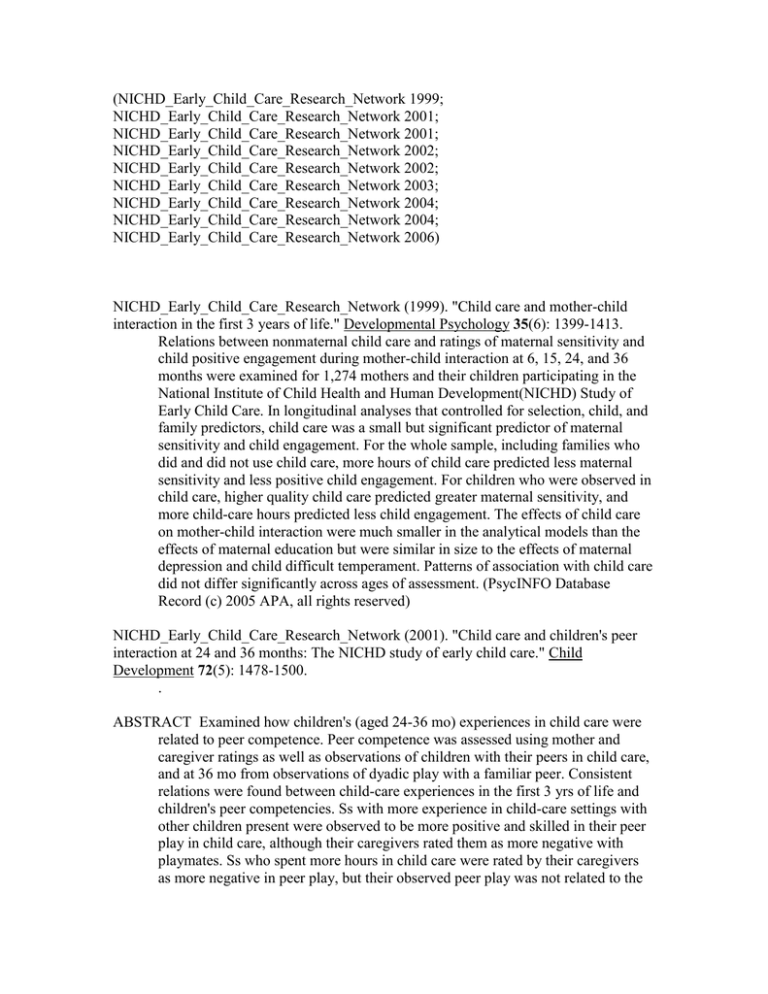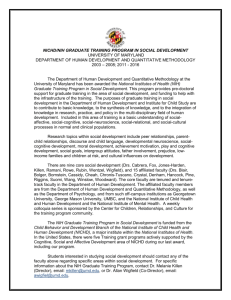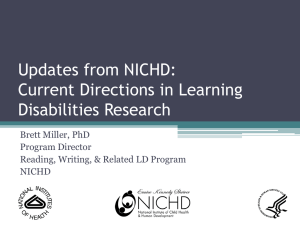
(NICHD_Early_Child_Care_Research_Network 1999;
NICHD_Early_Child_Care_Research_Network 2001;
NICHD_Early_Child_Care_Research_Network 2001;
NICHD_Early_Child_Care_Research_Network 2002;
NICHD_Early_Child_Care_Research_Network 2002;
NICHD_Early_Child_Care_Research_Network 2003;
NICHD_Early_Child_Care_Research_Network 2004;
NICHD_Early_Child_Care_Research_Network 2004;
NICHD_Early_Child_Care_Research_Network 2006)
NICHD_Early_Child_Care_Research_Network (1999). "Child care and mother-child
interaction in the first 3 years of life." Developmental Psychology 35(6): 1399-1413.
Relations between nonmaternal child care and ratings of maternal sensitivity and
child positive engagement during mother-child interaction at 6, 15, 24, and 36
months were examined for 1,274 mothers and their children participating in the
National Institute of Child Health and Human Development(NICHD) Study of
Early Child Care. In longitudinal analyses that controlled for selection, child, and
family predictors, child care was a small but significant predictor of maternal
sensitivity and child engagement. For the whole sample, including families who
did and did not use child care, more hours of child care predicted less maternal
sensitivity and less positive child engagement. For children who were observed in
child care, higher quality child care predicted greater maternal sensitivity, and
more child-care hours predicted less child engagement. The effects of child care
on mother-child interaction were much smaller in the analytical models than the
effects of maternal education but were similar in size to the effects of maternal
depression and child difficult temperament. Patterns of association with child care
did not differ significantly across ages of assessment. (PsycINFO Database
Record (c) 2005 APA, all rights reserved)
NICHD_Early_Child_Care_Research_Network (2001). "Child care and children's peer
interaction at 24 and 36 months: The NICHD study of early child care." Child
Development 72(5): 1478-1500.
.
ABSTRACT Examined how children's (aged 24-36 mo) experiences in child care were
related to peer competence. Peer competence was assessed using mother and
caregiver ratings as well as observations of children with their peers in child care,
and at 36 mo from observations of dyadic play with a familiar peer. Consistent
relations were found between child-care experiences in the first 3 yrs of life and
children's peer competencies. Ss with more experience in child-care settings with
other children present were observed to be more positive and skilled in their peer
play in child care, although their caregivers rated them as more negative with
playmates. Ss who spent more hours in child care were rated by their caregivers
as more negative in peer play, but their observed peer play was not related to the
quantity of care. Child-care experiences were not associated with peer
competence as rated by mothers or as observed in dyadic play with a friend.
Maternal sensitivity and children's cognitive and language competence predicted
peer competence across all settings and informants, suggesting that family and
child-care contexts may play different, but complementary roles in the
development of early emerging individual differences in peer interaction.
NICHD_Early_Child_Care_Research_Network (2001). "Nonmaternal care and family
factors in early development: An overview of the NICHD Study of Early Child Care."
Journal of Applied Developmental Psychology 22(5): 457-492.
ABSTRACT (from the journal abstract) In the most comprehensive US study to
date about connections among child care experiences, family factors, and
children's early development, 1,100 children have been followed from birth
through age 7. The study's intent is to describe family and child care/school
contexts of children's development and examine associations between contextual
variations and children's developmental outcomes in social-emotional, cognitive,
and physical health domains. By age 3, over 90% of the children had experienced
regular nonmaternal care, and over 50% were regularly spending over 30
hours/week in care. Economic factors, family characteristics, and maternal
attitudes all influenced the amount and nature of early nonmaternal care.
Observed quality of nonmaternal care consistently predicted social-emotional and
cognitive-linguistic outcomes during the first 3 years of life. Amount of time
spent in nonmaternal care predicted some social-emotional outcomes. Type and
stability of nonmaternal care had limited predictive value. Family factors,
including maternal sensitivity, quality of home environment, and income, were
more consistent predictors of children's outcomes than any aspect of early
nonmaternal care experiences. (PsycINFO Database Record (c) 2002 APA, all
rights reserved)
AUTHOR NICHD Early Child Care Research Network; Allhusen, Virginia; Appelbaum,
Mark; Belsky, Jay; Booth, Cathryn L.; Bradley, Robert; Brownell, Celia;
Burchinal, Peg; Caldwell, Bettye; Campbell, Susan; Clarke-Stewart, Alison; Cox,
Martha; DeHart, Ganie; Friedman, Sarah L.; Hirsh-Pasek, Kathryn; Huston,
Aletha; Jaeger, Elizabeth; Johnson, Deborah; Kelly, Jean; Knoke, Bonnie;
Marshall, Nancy; McCartney, Kathleen; O'Brien, Marion; Owen, Margaret
Tresch; Payne, C. Chris; Phillips, Deborah; Pianta, Robert; Randolph, Suzanne;
Robeson, Wendy Wagner; Spieker, Susan J.; Vandell, Deborah Lowe; WallnerAllen, Kathleen E.; Weinraub, Marsha
NICHD_Early_Child_Care_Research_Network (2002). "Child-care structure-->process->outcome: Direct and indirect effects of child-care quality on young children's
development." Psychological Science 13(3): 199-206.
ABSTRACT With data from the NICHD Study of Early Child Care, this study
used structural equation modeling to test paths from structural indicators of childcare quality, specifically caregiver training and child-staff ratio, through a process
indicator to child outcomes. Ss included children who were followed from birth
through age 54 mo and mothers who were interviewed in person when their
infants were age 1 mo. There were 3 main findings: (a) Quality of maternal
caregiving was the strongest predictor of cognitive competence, as well as
caregivers' ratings of social competence; (b) quality of nonmaternal caregiving
was associated with cognitive competence and caregivers' ratings of social
competence; and (c) there was a mediated path from both caregiver training and
child-staff ratio through quality of nonmaternal caregiving to cognitive
competence, as well as to caregivers' ratings of social competence, that was not
accounted for entirely by family variables. These findings provide empirical
support for policies that improve state regulations for caregiver training and childstaff ratios. (PsycINFO Database Record (c) 2002 APA, all rights reserved)
NICHD_Early_Child_Care_Research_Network (2002). "Early child care and children's
development prior to school entry: Results from the NICHD Study of Early Child Care."
American Educational Research Journal 39(1): 133-164.
ABSTRACT Examined the effects of early child care on children's cognitive and social
functioning at the age of 4.6 yrs, in the National Institute of Child Health and
Human Development Study of Early Child Care, a prospective longitudinal study
of 1,364 children followed from birth. Child care measures focused on type,
quantity and quality of care. Child functioning assessed at 4.6 yrs included
preacademic skills, short term memory, language and social competence, and
behavior problems. Results of interviews and observations show that, even after
controlling for child and family characteristics, children's development was
predicted by early child-care experience. Higher-quality child care, improved
quality of child care, and experience in center-type arrangements predicted better
preacademic skills and language performance at 4.6 yrs. More hours of care
predicted higher levels of behavior problems, according to caregivers. Effect sizes
associated with early child-care experiences were evaluated in relation to effect
sizes obtained for 2 other well-recognized influences on early development:
parenting and poverty. The findings indicate the importance (and relative
independence) of quantify, quality, and type of child care for children's
development just prior to beginning formal schooling. (PsycINFO Database
Record (c) 2002 APA, all rights reserved)
AUTHOR No authorship indicated
NICHD_Early_Child_Care_Research_Network (2003). "Does quality of child care affect
child outcomes at age 4 1/2?" Developmental Psychology 39(3): 451-469.
Research reveals associations between child-care quality and child outcomes. But
are these associations causal? Data from the National Institute of Child Health and
Human Development (NICHD) Study of Early Child Care, a longitudinal study of
children from birth to age 4 1/2, were used to explore 5 propositions that would
support a causal argument. Three propositions received support, principally in the
cognitive domain: (a) Associations between quality and outcomes remained even
with child and family factors controlled; (b) associations between care and
outcomes were domain specific; and (c) outcomes were predicted by quality of
earlier care with concurrent care controlled. The 4th proposition, that associations
between quality and outcomes would be significant with earlier abilities
controlled, received limited support. There was no support for the 5th proposition,
that quality and outcomes would exhibit dose-response relations. (PsycINFO
Database Record (c) 2005 APA, all rights reserved)
NICHD_Early_Child_Care_Research_Network (2004). "Are Child Developmental
Outcomes Related to Before- and After-School Care Arrangements? Results From the
NICHD Study of Early Child Care." Child Development 75(1): 280-295.
Data from the National Institute of Child Health and Human Development
(NICHD) Study of Early Child Care, a prospective, longitudinal study involving
933 children, were used to examine relations between cumulative participation in
5 types of out-of-school care (before- and after-school programs, extracurricular
activities, sitters, fathers, and nonadult care) and child developmental outcomes in
the latter part of first grade (approximately age 7 years). Children who
consistently participated in extracurricular activities during kindergarten and first
grade obtained higher standardized test scores than children who did not
consistently participate in these activities, controlling for child and family factors
and children's prior functioning. Participation in other types of out-of-school care
was not associated with child functioning in first grade when background factors
were controlled. (PsycINFO Database Record (c) 2005 APA, all rights reserved)
NICHD_Early_Child_Care_Research_Network (2004). "Trajectories of Physical
Aggression From Toddlerhood to Middle Childhood." Monographs of the Society for
Research in Child Development 69(4): vii-129.
Maternal reports of physical aggression from 24 months to third grade were
examined in a diverse sample of over 1,100 children participating in the NICHD
Study of Early Child Care and Youth Development. Most children showed low
levels of aggression that declined over time. A person-centered analysis identified
five aggression trajectories: two low-aggression trajectories and three trajectories
characterized by at least moderate aggression at some point between 24 months
and third grade. One trajectory group evidenced moderate aggression at 24
months that declined steeply; another showed modest aggression at 24 months
that remained elevated at third grade. The fifth and smallest trajectory group
showed high and stable aggression. Higher levels of family resources and more
sensitive parenting predicted low levels of aggression, whereas higher
sociodemographic risk and less sensitive, involved parenting, assessed from
infancy through third grade, predicted higher and more stable aggression. Childcare parameters were not systematically related to aggression trajectories. Higher
trajectories of aggression predicted poorer social and academic outcomes in third
grade, whereas aggression evident in toddlerhood that declined by school entry
was not associated with problematic functioning in third grade. Children in the
two higher aggression trajectories also differed from one another in the type and
severity of their problems in third grade. Some of these findings were confirmed
when variable-centered data analyses were conducted. However, the person-
centered analysis identified subgroups of children whose trajectories of
aggression were obscured in the variable-centered analysis. Results indicate that
not all aggressive toddlers are necessarily on a high-risk pathway; the course of
aggression through early childhood is an important predictor of outcomes in
middle childhood, and physical aggression tends to be more stable in the context
of family adversity. Distinctions are drawn between normative, age-related
aggressive behavior, and problematic aggression that emerges in early childhood.
(PsycINFO Database Record (c) 2005 APA, all rights reserved)
NICHD_Early_Child_Care_Research_Network (2006). "Infant-mother attachment
classification: Risk and protection in relation to changing maternal caregiving quality."
Developmental Psychology 42(1): 38-58.
The relations between early infant-mother attachment and children's social
competence and behavior problems during the preschool and early school-age
period were examined in more than 1,000 children under conditions of
decreasing, stable, and increasing maternal parenting quality. Infants' Strange
Situation attachment classifications predicted mothers' reports of children's social
competence and teachers' reports of externalizing and internalizing behaviors
from preschool age through 1st grade. These relations appeared to be mediated by
parenting quality; main effects of attachment classification disappeared when
effects of parenting quality were controlled. Interactions were also observed. For
example, when parenting quality improved over time, teachers rated children with
insecure infant-mother attachments lower on externalizing behaviors; when
parenting quality decreased, teachers rated insecure children higher on
externalizing behaviors. In contrast, children classified as securely attached in
infancy did not appear to be affected by declining or improving parenting quality.
(PsycINFO Database Record (c) 2006 APA, all rights reserved)








